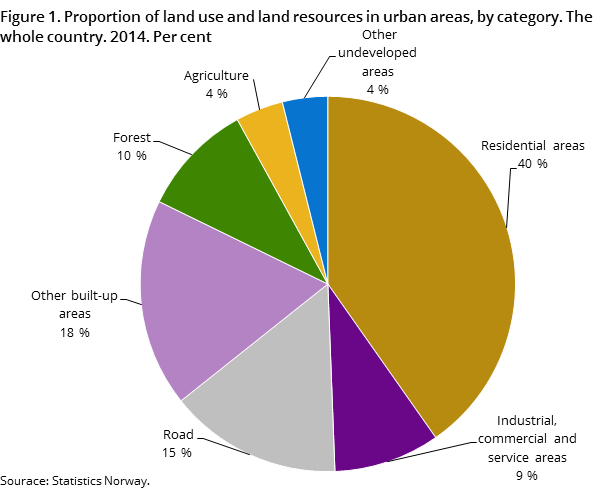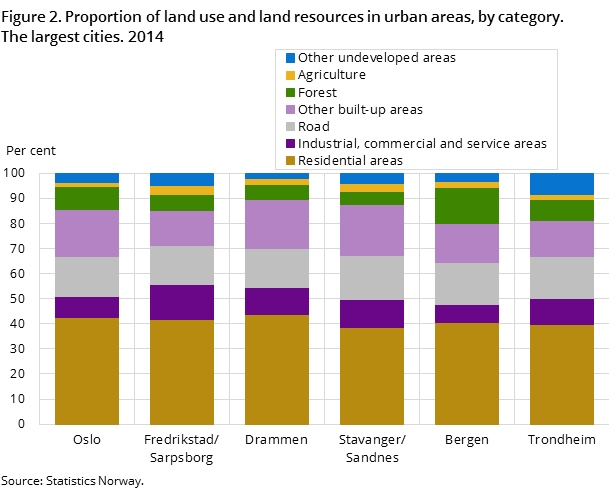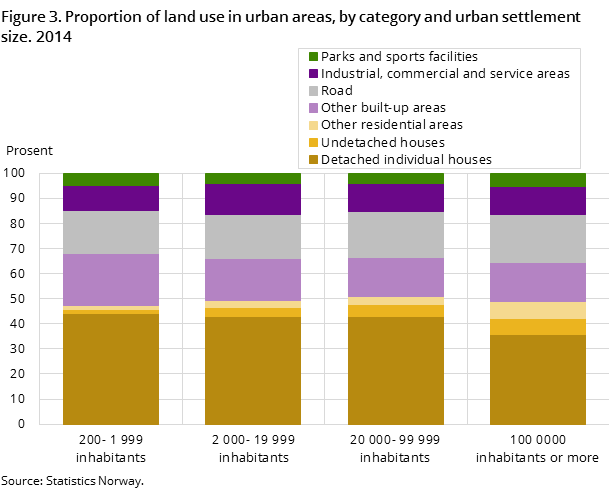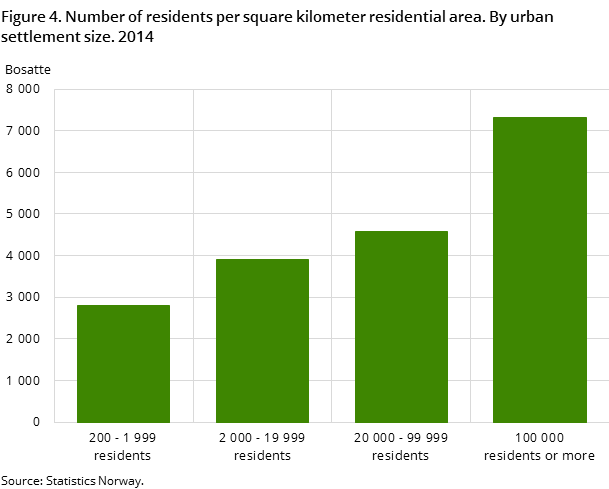Content
Published:
This is an archived release.
High share of residential purposes in urban areas
Eighty per cent of urban areas in Norway are built-up. Half of this, i.e. 40 per cent, is used for residential purposes. Land used for roads covers 15 per cent, and areas used for business and administration services make up 9 per cent of urban areas.
| 2014 | |||
|---|---|---|---|
| 200- 19 999 residents | 20 000- 99 999 residents | 100 000 or more residents | |
| Residential areas | 39.1 | 42.3 | 41.4 |
| Industrial, comercial and service areas | 9.0 | 9.1 | 9.4 |
| Road | 14.1 | 15.4 | 16.2 |
| Other built-up areas | 18.6 | 16.1 | 17.6 |
| Forest | 9.8 | 11.2 | 8.8 |
| Agriculture | 5.4 | 2.9 | 2.2 |
| Other undeveloped areas | 4.0 | 3.0 | 4.2 |




Urban settlements with more than 100 000 inhabitants have the highest share of built-up areas, at 85 per cent. For urban settlements with less than 20 000 inhabitants, the share is 81 per cent.
Built-up areas by size of urban settlement
Urban settlements with less than 2 000 inhabitants have a lower share of residential areas than the larger urban settlements. Overall, detached individual houses take up much of the ground used for residential purposes; about 85 per cent, while more densely developed residential areas make up the other 15 per cent. The larger urban settlements however have a lower share of the detached individual houses area (73 per cent), while the share of densely developed residential areas is higher (27 per cent).
The share of areas used for business and administration services is slightly lower in the smallest urban settlements (less than 2 000 inhabitants). Areas used for parks and sports facilities comprise about 5 per cent of the urban settlements, independent of size. The share of urban areas used for roads increases slightly with the size of the urban settlement, from 17-19 per cent of the built-up area.
Land use in the largest cities
Among the largest urban settlements (with more than 100 000 inhabitants), Drammen has the largest share of built-up area, at 90 per cent. The urban settlements of Bergen and Trondheim have the lowest share of built-up areas. Drammen has the highest share of residential areas, with 43 per cent. Fredrikstad/Sarpsborg has the highest share of business and administration services (14 per cent).
Population within residential areas
The number of inhabitants in residential areas increases with the size of the urban settlement. Urban settlements with less than 2 000 inhabitants have slightly less than 3 000 inhabitants per square kilometre of residential area, while the corresponding figure for the largest urban settlements is more than 7 000. In the smallest urban settlements, each inhabitant has about 350 square metres of residential area at their disposal, and in urban settlements with more than 100 000 inhabitants the corresponding figure is about 140 square metres.
The delimitation of urban settlements and land useOpen and readClose
The previous method used for delimiting urban settlements gave a zone of undeveloped area at the edge of the urban settlements. This contributed to a high share of undeveloped areas within the urban settlements. The new method introduced in 2013 will, in most cases, follow the boundary of built-up elements. Undeveloped areas at the edge will no longer be part of the urban settlements, but they will be included if they are surrounded by built-up areas.
Contact
-
Margrete Steinnes
E-mail: margrete.steinnes@ssb.no
tel.: (+47) 95 73 55 54
-
Svein Johan Reid
E-mail: sjr@ssb.no
tel.: (+47) 41 51 29 66
